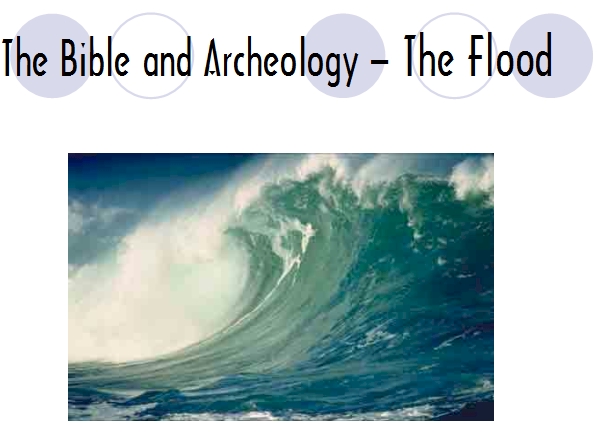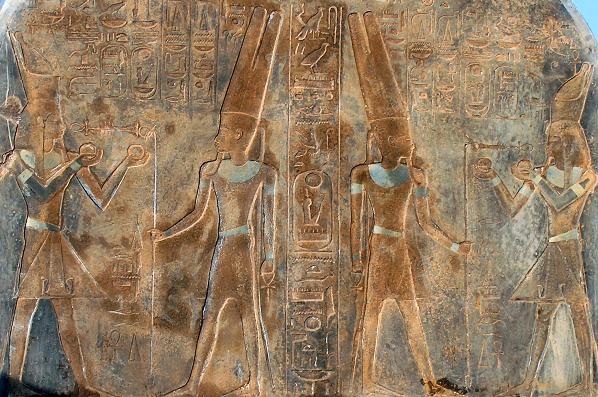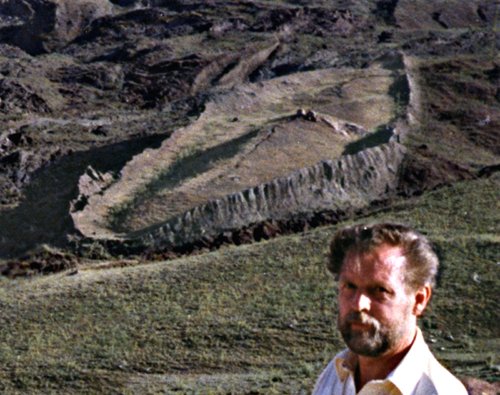|
DPS Biblical
Archeology Study Outline
3. Theories of the Flood
|

Download: Teacher's Script: (PDF)
(Word) |
Handout: (PDF) (Word) |
PowerPoint
Overview
a.
Inscriptions and Writings: Israel Stele
b.
Scripture Reading: Genesis 7:1-20
c. Theories of
the Flood
d.
Another Mesopotamian flood account from the Gilgamesh Epic
e.
The quest for Noah’s arc
Discussion Questions
____________________________________________________
a.
Inscriptions and Writings: Israel Stele
 Also known as the Israel Stele or
Victory Stele of Merneptah, it is the reverse of a large granite stele
originally erected by the Ancient Egyptian king Amenhotep III, but later
inscribed by Merneptah who ruled Egypt from 1213 to 1203 BC. The black
granite stele primarily commemorates a victory in a campaign against the
Libu and Meshwesh Libyans and their Sea People allies, but its final two
lines refer to a prior military campaign in Canaan in which Merneptah
states that he defeated Ashkelon, Gezer, Yanoam and Israel among others. Also known as the Israel Stele or
Victory Stele of Merneptah, it is the reverse of a large granite stele
originally erected by the Ancient Egyptian king Amenhotep III, but later
inscribed by Merneptah who ruled Egypt from 1213 to 1203 BC. The black
granite stele primarily commemorates a victory in a campaign against the
Libu and Meshwesh Libyans and their Sea People allies, but its final two
lines refer to a prior military campaign in Canaan in which Merneptah
states that he defeated Ashkelon, Gezer, Yanoam and Israel among others.
The stele has gained much
notoriety for being the only Ancient Egyptian document
generally accepted as mentioning "Isrir" or "Israel". It is also, by
far, the earliest known attestation of Israel. For this reason, many
scholars refer to it as the "Israel stele". This title is somewhat
misleading because the stele is clearly not concerned about Israel— in
fact, it mentions Israel only in passing. There is only one line about
Israel: "Israel is wasted, bare of seed" or "Israel lies waste, its seed
no longer exists" and very little about the region of Canaan. Israel is
simply grouped together with three other defeated states in Canaan (Gezer,
Yanoam and Ashkelon) in the stele.
b.
Scripture Reading: Genesis 7:1-20
c. Theories of the Flood
In
the six hundredth year of Noah’s life, in the second month, on the
seventeenth day of the month, on the same day all the fountains of the
great deep burst open, and the floodgates of the sky were opened.
(Genesis 7:11).
The chronological specifics indicate that we are meant to understand
this as an actual historical event. But what is the nature of this
event?
The phrase most translations render as “floodgates of the sky” is Aruboth
haShama’im and is more properly translated with “windows of heaven.” This exact same
term is found in Malachi 3:10 where the Lord is pictured as opening the
windows of heaven to pour out blessings on His people (this kind of
usage is also seen in 2 Kings 7:2,19). The idea of the windows from
above being opened in order to bring destruction is pictured in Isaiah
24:18.
Then it will be that he who flees the report of disaster will fall into
the pit, and he who climbs out of the pit will be caught in the snare;
for the windows above are opened, and the foundations of the earth
shake. (Isaiah 24:18).
In
the same way, “all the fountains of the great deep” has its parallels
such as Deuteronomy 4:18 where we read of fish that are “in the water
below the earth.” Thus, the picture is that of the sky and the ocean
loosening their bonds so that their waters fall upon the land.
Was this a world-wide flood or was it merely limited to the geographical
area of Mesopotamia?
1.
Arguments for a Universal Flood.
a.
The depth of the flood.
Genesis 7:19-20 says that ALL the high mountains which were under ALL
the heavens were covered by the waters of the flood.
The peak of Mount Ararat extends to an elevation of around 17,000 feet.
If only this one single peak was covered, then most of the world would
also be covered.
b.
The duration of the flood.
The flood is said to have lasted 371 days – a little over a year. Local
floods do not last this long.
c.
The need for the ark.
If
the flood was to be merely confined to a certain isolated area, it would
not have been necessary for Noah to build a big ship. He could have
moved to higher ground.
2.
Arguments for a Local Flood.
a.
HaAretz is “the land.”
The Hebrew word which is translated “the world” throughout the flood
narrative (HaAretz) can be translated “the land.”
“The LAND of Nod” (Genesis 4:16).
“In the LAND of Shinar” (Genesis 10:10).
“Out of that LAND went forth Asshur” (Genesis 10:11).
Each of these instances uses the same basic word. It can refer to the
entire world, or it can merely refer to a certain area of land.
By
the same token, when the Bible says that the world was covered by water,
we need not take this to refer to the entire planet earth. It could
merely be a reference to that land area.
b.
Universalist terms can be used in a limited sense.
The Scriptures sometimes use terms like “all” and “every” in a way which
is understood to be a limited sense.
Most people who advocate a universal flood do not take this command to
refer to ocean animals. Thus even the universalist understands that there are times when universal language is
used in a limited sense. Therefore when we read of every living thing
being destroyed in the flood, we can understand it to refer to the
living land animals in that particular area, not necessarily to a flood
which covered the entire planet.
c.
Where did the water go?
Mount Everest rises over 5 miles above sea level. There are many other
mountains in the world which are over the 3 mile mark.
For flood waters to cover the earth would mandate that either the
mountains were not there (thus they would have to be very recent in
origin) or else that water came from some supernatural source and then
went away again. Another possibility would be that the ocean beds
somehow sank to collect the excess water.
It
is interesting to note that sediment deposits have been found underneath
the Sumerian ruins at Ur, at Fara and at Kish, lending some credence to
the theory of a local flood.
3.
Summary.
|
UNIVERSAL FLOOD |
LOCAL FLOOD |
|
The purpose of the ark was punishment of world-wide sin. In a local
flood some could have escaped. |
The word aretz is often used to describe a local area. |
|
The authors of Genesis use language of
totality. |
The account is given from the viewpoint of the narrator is from his
perspective; from that viewpoint the destruction is total. |
|
The the ark indicates that this was no local flood. A vessel
of this size would not have been needed to escape a local flood. |
The ark, even though very big, could have never contained all then
living species of animals. |
d.
Another Mesopotamian flood account from the Gilgamesh Epic
A
number of “Flood Traditions” have come down to us from a number of
ancient cultures. The most popular of these in the one found in the
Gilgamesh Epic.
The Epic of Gilgamesh is a long Akkadian poem on the theme of human
beings’ futile quest for immortality. A number of earlier Sumerian
stories about Gilgamesh, the quasi-historical hero of the epic, were
used as sources, but the Akkadian work was composed about 2000 BC. It
exists in several different recensions, none of them complete.
In
the story, Gilgamesh and his friend Enkidu seek immortality through
fame, but when Enkidu dies, Gilgamesh finds that fame to be hollow.
Unable to accept the finality of death, he goes to Utnapishtim, the
Babylonian counterpart of the biblical Noah, to learn the secret of his
immortality.
This interview takes place on the 5th of seven tablets. Utnapishtim
tells the story of how he was spared the destruction of the great flood
through the building of a giant square barge.
o
The boat consisted of seven decks and was overlaid with pitch.
o
It took only seven days to build it.
o
Utnapishtim saved his family and relatives along with animals and
craftsmen.
o
The flood began when “the gods of the abyss rose up; Nergal pulled out
the dams of the nether waters, Ninutra the war-lord threw down the
dykes, and the seven judges of hell, the Annunaki, raised their torches,
lighting the land with their livid flame.”
o
The storm lasted for 6 days and nights after which “the surface of the
sea stretched as flat as a roof-top.”
o
The boat landed atop the mountain of Nisir. After seven days on the
mountain, Utnapishtim released a dove, then a swallow, and finally a
raven before leaving the boat and making a sacrifice to the gods.
Utnapishtim goes on to explain that he received eternal life due to the
unique circumstances of the flood, but he consoles the dejected
Gilgamesh with news about a plant of life. A snake swallows the plant
before Gilgamesh can use it, however, and he finally returns home,
reluctantly accepting death without future resurrection as inevitable.
e.
The quest for Noah’s Arc
Modern searches of Noah’s Ark (1949 to present)*
-
 In the 1980s and 1990s the Durupınar site was heavily
promoted by Ron Wyatt. It receives a steady stream of visitors and
according to the local authorities a nearby mountain is called "Mount
Cudi" making it one of about five Mount Judis in the land of
Kurdistan. Geologists have identified the Durupınar site as a natural
formation but Wyatt's Ark Discovery Institute continues to champion
its claims. In the 1980s and 1990s the Durupınar site was heavily
promoted by Ron Wyatt. It receives a steady stream of visitors and
according to the local authorities a nearby mountain is called "Mount
Cudi" making it one of about five Mount Judis in the land of
Kurdistan. Geologists have identified the Durupınar site as a natural
formation but Wyatt's Ark Discovery Institute continues to champion
its claims.
In June 2006, Bob Cornuke of the
Bible Archeology Search and Exploration Institute took a team of 14
American "business, law, and ministry leaders" to Iran to visit a site in the
Alborz Mountains, purported to be a possible resting place of the Ark.
The team claimed to have discovered an "object" 13,000 feet above sea
level, which had the appearance of blackened petrified wooden beams,
and was "about the size of a small aircraft carrier" [400 ft long (120
m)], and supposedly consistent with the dimensions provided in Genesis
of 300 cubits by 50 cubits. The team also claimed to have found
fossilized sea creatures inside the petrified wood, and in the
immediate vicinity of the site. One member of the team claimed that 'a
Houston lab used by the Smithsonian' tested some beams and confirmed
they were petrified wood containing fossilized sea animals, but the
name of the laboratory was not given. No one outside the expedition
has offered independent confirmation, and apart from a few purported
beams, no photographic images of this supposed Ark in its entirety
have been made available (though short video segments have been made
available). The team's consensus on the "object" is not absolute; Reg
Lyle, another expedition member, described the find as appearing to be
"a basalt dike". It is the official position of the BASE Institute
that Iran was the logical resting place of the Ark. Their website does
not definitely claim the object to be the Ark, but concludes that it
is "a candidate"
-
In 2007, a joint Turkish-Hong Kong expedition including
members of Noah's Ark Ministries International claimed to have found
an unusual cave with fossilized wooden walls on Mount Ararat, well
above the vegetation line.
-
In 2010, Noah's Ark Ministries International l (NAMI)
released videos of their discovery of the wood structures. Members of
Noah's Ark Ministries International reported carbon dating suggests
the wood is approximately 4,800 years old. It is unlikely that there
was any human settlement at the site at altitude of 4,000 meters.
Randall Price, a partner with Noah's Ark Ministries International
from early 2008 to the summer of 2008, stated that the discovery was
probably the result of a hoax, perpetrated by ten Kurdish workers
hired by the Turkish guide used by the Chinese, who planted large wood
beams taken from an old structure near the Black Sea at the cave site.
In a response to Price, Noah’s Ark Ministries International stated
that they had terminated co-operation with Price in early October
2008, and that he had never been in the location of the wooden
structure they identified, and regretted his absence in their find.
________________________________________
*From a Wikipedia article found at
http://en.wikipedia.org/wiki/Searches_for_Noah's_Ark
Discussion Questions:
What are we to make of the fact that a document predating the book of
Genesis also contains a story of the flood with many of the same aspects
of the Biblical account? Does this mean that the biblical account has
been copied? Or does it attest to the strong possibility of the Flood
as an actual event? What theory of the flood do you find plausible? A
universal flood or an extended local flood? Would a positive
identification of fossilized pieces of the ark make a difference to your
faith?
|